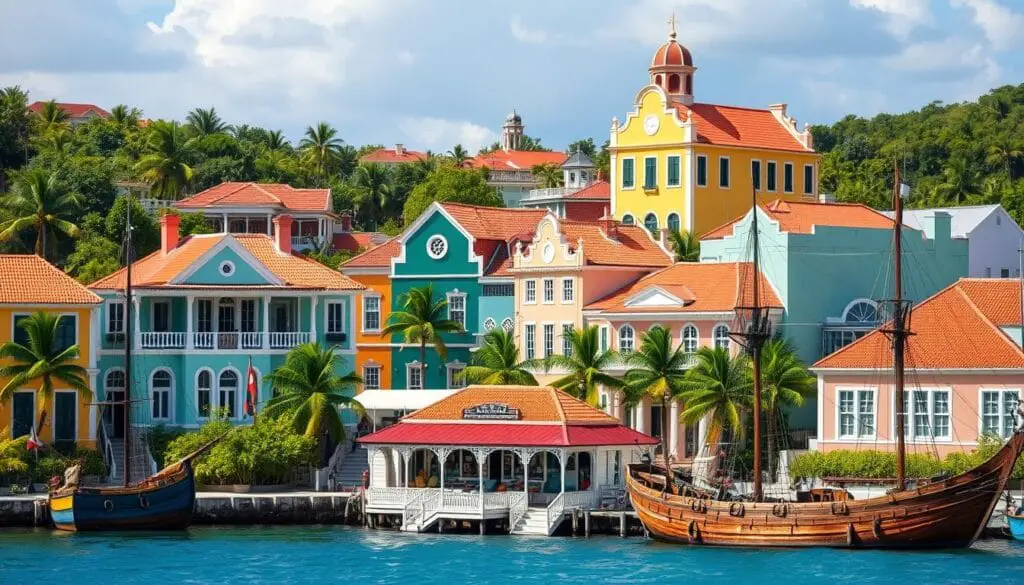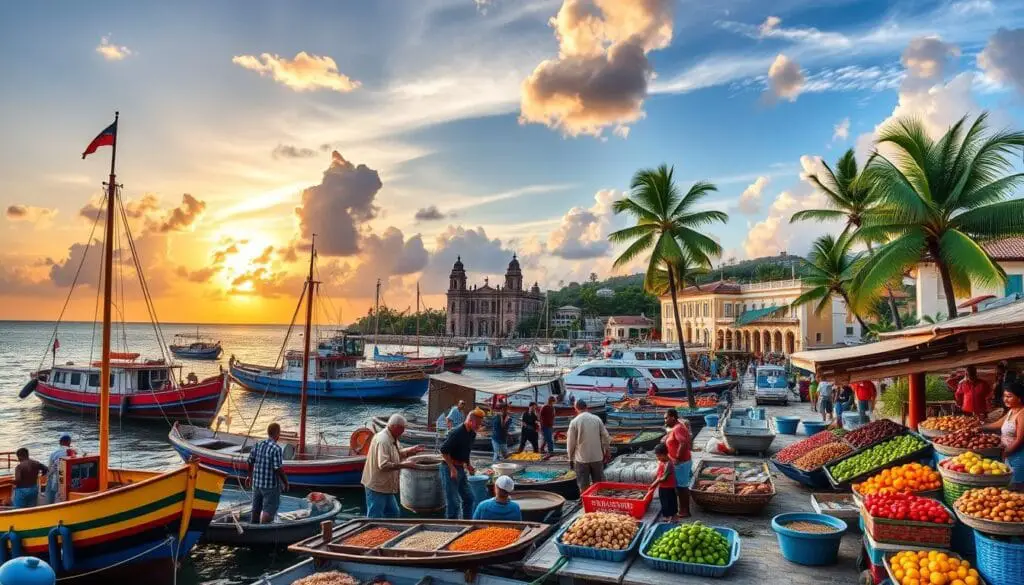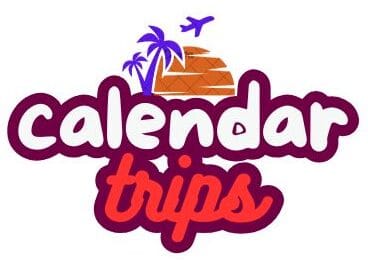Where Is Curaçao in the Caribbean? 7 Key Facts You Need to Know
Have you ever looked out at the Caribbean’s clear blue waters and wondered about hidden spots? Curaçao, a beautiful island, is one such gem. It’s located in the southern Caribbean and is often overlooked. But today, we’re going to explore where Curaçao is and why it’s a must-see destination.
Table of Contents
Where Is Curaçao in the Caribbean: Exact Location and Coordinates
Curaçao is a vibrant island in the southern Caribbean Sea. It’s about 65 kilometers north of Venezuela. It’s part of the Lesser Antilles and the ABC Islands, along with Aruba and Bonaire.
This location outside the hurricane belt makes Curaçao’s climate favorable. It has less risk of tropical storms than other Caribbean places.
Strategic Position in the ABC Islands
Curaçao is close to South America and the Caribbean Sea. This mix of cultures and endless exploration makes it special. It’s part of the ABC Islands, offering a unique Caribbean experience.
Distance from Major Landmarks
Curaçao is about 40 miles (65 kilometers) north of Venezuela. This spot in the southern Caribbean is strategic. It’s close to South America but still has its own culture and identity.
Geographic Coordinates and Maritime Boundaries
Curaçao’s coordinates are 12.19462672° N latitude and -68.97331748° W longitude. It’s in the ABC Islands and the southern Caribbean. Its maritime boundaries are in the Caribbean Sea to the north and with Venezuela to the south.
| Characteristic | Value |
|---|---|
| Size | 431.1 km² |
| Coastline | 224.2 km |
| Highest Elevation | Approximately 193 meters above sea level |
| Mean Elevation | 34 meters |
| Tree Coverage | 23% |
| Population Density | 404 per km² |
The Cultural Heritage of Willemstad: A UNESCO World Heritage Site
The city of Willemstad, Curaçao is in the southern Caribbean. It has been a UNESCO World Heritage Site since 1997. This city is known for its lively mix of Dutch Caribbean influences and rich culture.
Willemstad has around 150,000 people. It’s divided into historic districts like Punda, Otrobanda, Pietermaai, and Scharloo. These areas show off the city’s pastel-colored Dutch colonial architecture along the waterfront.
The Queen Emma Bridge is at the city’s heart. It’s a floating bridge that connects Punda and Otrobanda. This bridge is a symbol of the city’s engineering and heritage.
The Mikvé Israel-Emanuel Synagogue is a historic gem. It’s the oldest synagogue in the Americas, built in 1651. This synagogue shows the city’s diverse culture and its role in trade and commerce.
Willemstad is a mix of European, African, and Caribbean cultures. You can see this in its art, music, and food. Visitors can explore historic areas, museums, and festivals that celebrate the Dutch Caribbean.
Being a UNESCO World Heritage Site shows Willemstad’s cultural importance. It’s a living example of how colonial settlements in the Caribbean have changed over time. Willemstad attracts visitors with its history, architecture, and lively culture.
Natural Wonders and Landscapes That Define Curaçao
Curaçao is famous for its clear waters and rich marine life. It’s a top spot for snorkeling and diving. The island has beautiful beaches, dramatic coastlines, and lush national parks. These natural wonders will amaze anyone who visits.
Famous Beaches and Coves
Curaçao has over 30 stunning beaches, each with its own beauty. Places like Kenepa Beach and Playa PortoMari are breathtaking. Mambo Beach is also very popular.
Shete Boka National Park is a must-see. Here, the waves hit dramatic cliffs and hidden caves.
National Parks and Wildlife
Curaçao’s national parks show off the island’s natural diversity. Christoffel National Park covers over 2,300 acres. It’s home to unique plants and birds, including the famous divi-divi trees.
Jan Kok’s salt pans are great for seeing flamingos in the wild. It’s a rare chance to see these birds up close.
Marine Ecosystems and Coral Reefs
The underwater world of Curaçao is incredible. It has colorful coral reefs and lots of marine life. The Curaçao Underwater Marine Park, created in 1983, protects this world.
Here, you can see amazing coral gardens and marine creatures. Spot sea turtles, tropical fish, and even rays.
Curaçao’s beauty is a treat for all senses. It offers beautiful landscapes, diverse wildlife, and amazing marine life. Whether you love beaches, hiking, or diving, Curaçao has it all.
Historical Significance and Dutch Colonial Influence

Curaçao’s history is closely tied to the Dutch colonial era. Alonso de Ojeda found the island in 1499. Later, the Dutch West India Company took control in 1634.
During this time, Curaçao became a key spot in the slave trade. A Sephardic Jewish community thrived here in the 1600s.
The island’s past includes the Tula slave uprising in 1795. Yet, Dutch influence remains in Curaçao’s buildings, language, and government. It was part of the Netherlands Antilles until 2010, when it gained autonomy.
Curaçao’s location and history have greatly shaped its identity. From being a Dutch outpost to an independent nation, its curaçao history, dutch colonial influence, and role in the netherlands antilles have made it unique.
“Curaçao’s history is a testament to the lasting impact of Dutch colonial rule, shaping the island’s culture, language, and governance to this day.”
Climate and Weather Patterns: Outside the Hurricane Belt
Curaçao has a tropical savannah climate, with temperatures staying the same all year. The highs are between 78°F and 88°F (25°C to 31°C), perfect for beach fun and outdoor activities. It’s a safe spot for tropical getaways, away from the hurricane belt.
Year-round Temperature and Precipitation
The island has a dry season from January to September and a rainy one from October to December. In the dry season, there are short showers now and then. The rainy season brings more showers, but they’re still short. This weather lets visitors enjoy the beaches and outdoor spots all year.
Best Time to Visit
- May to November is the best time to visit Curaçao. You’ll find fewer people and lower prices.
- Curaçao’s sunny weather makes it a great place to visit any time. You can plan your trip whenever you like.
While the curaçao climate is mostly stable, there are occasional strong winds. These happen most in February and June. But, the caribbean weather on Curaçao is usually mild. The hurricane belt is far enough north to barely affect the island.
“Curaçao’s location outside the hurricane belt makes it a unique and appealing destination in the Caribbean, offering a tropical experience with minimal risk of severe storms.”
Transportation Hub: Getting to and Around Curaçao
Curaçao is a major transportation hub in the Caribbean. It offers easy ways to get around and travel. The Curaçao International Airport is just 12 kilometers from Willemstad. It has direct flights from Amsterdam, Miami, and New York, making it easy to reach.
For trips between islands, Curaçao connects well with other Caribbean places. The island’s cruise ship terminal in Willemstad welcomes visitors by sea. It’s a great way to start exploring the island’s many sights.
Getting around Curaçao is easy. You can use buses, taxis, or rent a car. The bus system includes big metro buses and smaller vans. Renting a car costs about $45 a day for more freedom.
Willemstad’s heart is connected by two famous bridges. The Queen Emma pontoon bridge and the Queen Juliana Bridge link Punda and Otrabanda. Walking is easy, and a ferry runs when the bridge is open for ships.
Arriving by air, sea, or land, Curaçao’s transport network makes travel smooth. It ensures a hassle-free journey through the Caribbean.
Vibrant Local Culture and Language Diversity
Curaçao is a mix of cultures, with over 154,000 people from more than 50 countries. This Caribbean island is known for its Afro-Creole and European roots. It celebrates its rich traditions and unique languages.
Papiamentu and Multilingual Society
Papiamentu is the main language of Curaçaoans, blending Dutch, Spanish, Portuguese, and African languages. It’s key to the island’s culture, used in daily life, media, education, and politics. Dutch and English are also official, used in government and international communication.
Cultural Festivals and Traditions
Curaçao’s culture shines through its festivals and traditions. The Curaçao Carnival in February is a colorful event that attracts global visitors. The Seú harvest parade in April and the Curaçao North Sea Jazz Festival in August/September also highlight the island’s music and food.
The island’s music includes tumba, mazurka, and waltz. Its food mixes African, Dutch, and Spanish tastes, offering a unique taste experience.
Curaçao’s culture, language variety, and friendly people make it a great place for cultural exploration in the Caribbean.
Economic Significance in the Southern Caribbean

Curaçao’s economy is a mix of tourism, oil refining, and financial services. It’s key to the Southern Caribbean. The island’s location and business-friendly climate make it a trade and commerce center.
The Isla Refinery, leased to Venezuela, boosts Curaçao’s economy. The Free Trade Zone draws global businesses. Tourism, especially from Europe and North America, is also growing. The Curaçao Liqueur factory adds to the local economy and exports.
Fishing and agriculture are small parts of Curaçao’s economy. But, its offshore financial center with low taxes attracts international businesses and wealthy individuals. The government is working to diversify the economy, beyond oil refining, with sustainable business growth.
“Developing Sustainable Business Together. We enable, connect, and transform.”
– The new slogan of 2Bays Curaçao
Curaçao’s location, infrastructure, and policies make it a major player in Caribbean trade and curaçao economy. As it evolves, its economic role in the region will likely increase.
Tourist Attractions and Hidden Gems
Curaçao, a vibrant Caribbean island, is full of attractions and hidden gems. You can see the colorful Dutch colonial buildings in Willemstad. The island’s natural wonders add to the fun, making Curaçao tourism unforgettable.
The Handelskade is a must-see, with its pastel buildings along the waterfront. The Queen Emma pontoon bridge connects Punda and Otrobanda, offering beautiful harbor views.
For marine life fans, the Caribbean attractions include the Curaçao Sea Aquarium and Dolphin Academy. Here, you can meet dolphins and see the underwater world. The Hato Caves show ancient Arawak Indian petroglyphs, giving a peek into Curaçao’s history.
Art lovers will enjoy Serena’s Art Factory and the street art in Pietermaai. For a local taste, visit the Blue Curaçao Liqueur distillery or the Floating Market in Punda.
For a unique adventure, go to Klein Curaçao. Enjoy its beaches, snorkel in clear waters, and find peace in the Willemstad sights.
Curaçao’s history, landscapes, and culture will captivate you. Its attractions and hidden gems make it a great place to explore in the Caribbean.
Conclusion: Why Curaçao Deserves Your Attention
Curaçao is a vibrant Dutch Caribbean island. It combines Caribbean charm with European influence. This makes it a top spot for Caribbean vacations. The island has warm weather all year, beautiful beaches, and a rich culture.
As a Dutch Caribbean island, Curaçao has a UNESCO World Heritage Site in Willemstad. This city shows off its amazing colonial architecture and history.
Curaçao offers many activities and experiences. You can dive, snorkel, visit historical sites, and see colorful art. The island has something for everyone.
Travelers can dive into the local culture, try different foods, and see the stunning beaches and parks. Curaçao is a great place to explore.
Curaçao is safe all year because it’s outside the hurricane belt. It’s perfect for a worry-free Caribbean vacation. The locals are friendly, and getting around is easy.
Whether you want to relax, have an adventure, or experience a new culture, Curaçao is the place to go. It’s a hidden gem in the Caribbean.
Recommended reading : 5 Reasons Why Visiting Cartagena in December is the Ultimate Winter Getaway
FAQ
Where is Curaçao located in the Caribbean?
Curaçao is a southern Caribbean island. It’s 40 miles north of Venezuela’s coast. It’s part of the ABC islands and the Kingdom of the Netherlands.
What are the coordinates of Curaçao?
Curaçao is at 12.2° N latitude and 69° W longitude.
Is Curaçao outside the hurricane belt?
Yes, Curaçao is outside the hurricane belt. It has year-round warm weather and is less prone to severe storms.
What is the capital city of Curaçao?
Willemstad is Curaçao’s capital. It’s a UNESCO World Heritage Site. It’s known for its colorful Dutch colonial architecture along the waterfront.
What are some of the popular natural attractions in Curaçao?
Curaçao has over 30 beaches. It also has Christoffel National Park, Shete Boka National Park, and world-class diving and snorkeling sites. These sites have vibrant coral reefs.
How is Curaçao’s cultural heritage influenced?
Curaçao’s culture is influenced by Dutch, Spanish, and African cultures. This is seen in its architecture, language, music, and cuisine.
What is the climate like in Curaçao?
Curaçao has a tropical savannah climate. Temperatures are consistent, averaging 78°F to 88°F (25°C to 31°C) year-round. The dry season, from January to September, is the best time to visit.
How can I get to Curaçao?
You can fly to Curaçao’s international airport from Amsterdam, Miami, and New York. You can also reach Curaçao by cruise ship or inter-island flights.
What languages are spoken in Curaçao?
Dutch, Papiamentu, and English are the official languages in Curaçao. Papiamentu is a unique Creole language spoken in the ABC islands.
What is the economy of Curaçao based on?
Curaçao’s economy is based on tourism, oil refining, and financial services. The island also has a Free Trade Zone that promotes international commerce.






